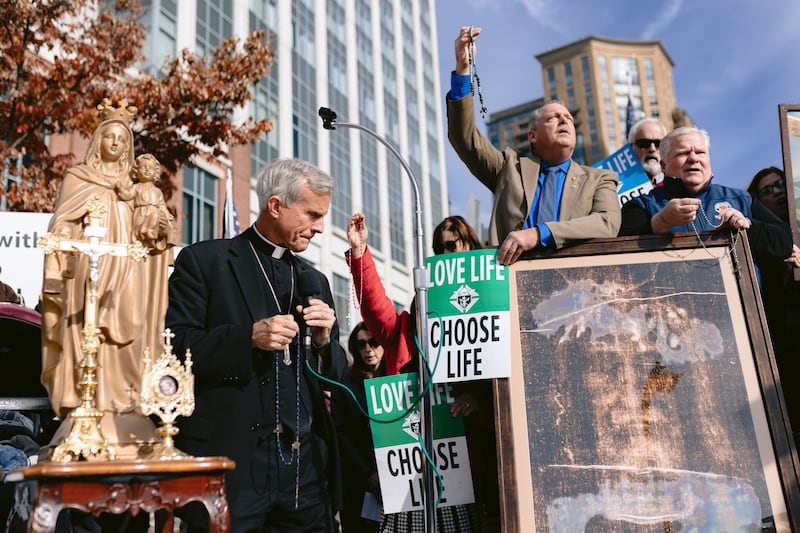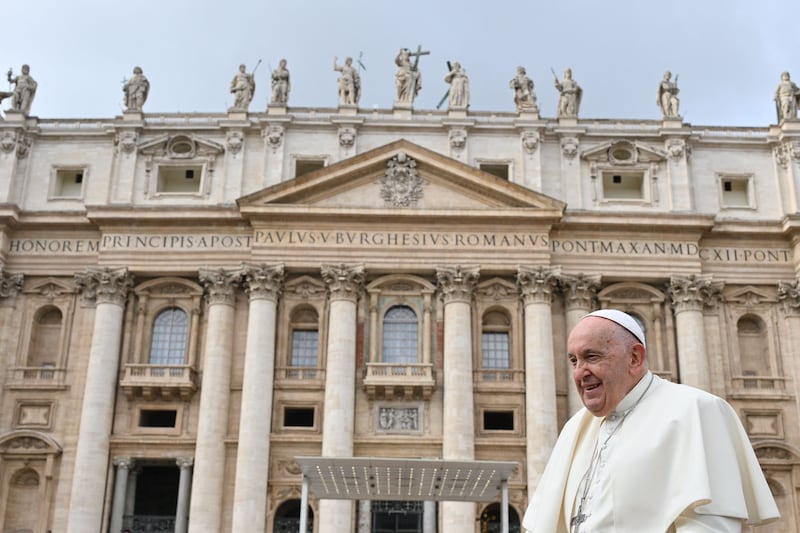The photograph released on the Vatican’s official news channels was in many ways unremarkable, showing a smiling nun meeting Pope Francis in his official residence.
But close observers of the Catholic Church recognised something far from routine. This nun was Sr Jeannine Gramick, an advocate for LGBT Catholics who through the decades had been denounced by church authorities and once even feared excommunication.
Here she was, being welcomed by the man at the top. “The meeting was very emotional for me,” Sr Gramick said after the encounter last month. It was described by her LGBT advocacy organisation New Ways Ministry as “once unimaginable”.
It was the latest sign of an apparent opening of the church under Francis towards the LGBT community, which has drawn tentative optimism from some more liberal believers, but the outrage of a conservative flank.
RM Block
[ Pope Francis’ removal of Texas bishop shows divisions between some US Catholics and Rome ]
[ Ten years of Pope Francis, the disrupterOpens in new window ]
It has deepened the suspicions of hardliners within the church that Francis is a dangerous reformer who risks worsening what they see as the confusion and undermining of church authority begun by the landmark 1960s Vatican II reforms.
Last weekend, Francis acted to impose his authority against a coterie of such traditionalists, who had become increasingly emboldened in airing public criticism.
Diabolically disordered clown
— Bishop Strickland criticising Pope Francis on Twitter
In a highly unusual move, the Vatican stripped Texas bishop Joseph Strickland of his position.
A vocal conservative and supporter of former US president Donald Trump, Strickland had been one of Francis’ fiercest critics in the United States, using a large media presence to criticise the pope’s efforts to give lay people responsibility and make the church more welcoming to LGBT people.

“Vatican officials promote immorality,” Strickland wrote on Twitter last year. In another message, he approvingly shared a video in which Francis was criticised as a “diabolically disordered clown”.
A church investigation had found “that the continuation in office of Bishop Strickland was not feasible”, the Vatican statement said.
Can Catholic beliefs change with the times?
This was one of the questions posed by five conservative cardinals to Francis this year, in a list of queries they published in an apparent open challenge to the pope.
Asked whether divine revelation can be reinterpreted based on the changing norms of the day, Francis responded: “If it is understood as ‘interpret better’, the expression is valid.” He said some aspects of the Bible are of their time, such as slavery.
In another question, the cardinals asked whether it is permissible to bless same-sex unions, as some Catholic churches in Germany and Belgium have begun to do.
While only traditional marriages are recognised as such, “we must not lose the pastoral charity”, Francis told the cardinals. “Pastoral prudence must adequately discern whether there are forms of blessing . . . that do not convey a mistaken concept of marriage.”
By telling the cardinals that same-sex unions could blessed on a case-by-case basis, Francis opened the door on a past taboo.

Since then, the pontiff has said that transgender people can be baptised, serve as witnesses and become godparents in some cases.
He has made clear that being gay is not in itself a “sin”, though remains of the view that homosexual acts are, along with all sexual activity outside traditional marriage.
But his papacy has striven to some extent to send the message that regardless, people should not be excluded from the church and denied pastoral care.
“If someone is gay and he searches for the Lord and has good will, who am I to judge?” he famously responded to a journalist shortly after his election in 2013.
Last month, former president of Ireland Mary McAleese, who is a doctor of Canon law, welcomed comments from Francis about blessings for same-sex couples but pointed out the pontiff’s stance is a “complete contradiction” of what he had said previously.
In December 2022, she accused him of “misogynistic drivel”, following an interview with a US-based Catholic magazine where he said women were not being deprived by being denied the right to become priests.
The life story of Sr Gramick starkly illustrates the shift in approach towards LGBT people since Francis became pope.
Sr Gramick began ministering to US LGBT communities in the 1970s and became an advocate for gay people within the church, holding workshops for Catholics that explained the spectrum of human sexuality.
This alarmed a number of bishops, and complaints triggered a Vatican investigation. The Vatican’s disciplinary arm, then led by the doctrinaire Cardinal Joseph Ratzinger – who would later become Pope Benedict XVI – publicly lambasted her for failing to accurately represent church teaching on “the intrinsic evil of homosexual acts”.
She was ordered to desist in her work in 1999. She did not.
Her organisation, New Ways Ministry, was censured for issuing a leaflet as marriage equality debates raged in 2010, outlining why Catholics might support legal unions for gay people. In response, US bishops declared the group could not describe itself as Catholic.
With the election of Pope Francis in 2013, however, change appeared to be in the air.
In a 2020 documentary, the pontiff said: “Homosexual people have a right to be in a family . . . What we have to create is a civil union law. That way they are legally covered.”
The comment landed in New Ways Ministry like a bombshell. “We were sanctioned by the US bishops for a position that the pope now held,” its executive director Francis DeBernardo recalled. “So I decided to write to Pope Francis.”
[ Pope Francis is wrong to declare female priests a ‘closed question’Opens in new window ]
To his shock, a response arrived swiftly from the man himself on official Vatican letterhead, beginning a correspondence between Francis and Sr Gramick. In 2022, Francis wrote to the nun to congratulate her on 50 years of ministry, thanking her for the “compassion and tenderness” of her work, and saying her willingness to feel the pain of others and “condemn no one” was in the “style of God”.
This exchange culminated in the meeting in person last month.
“It still feels a little unreal,” said DeBernardo, who was in the meeting with Francis. “To realise that we have approval from the highest level of the church, when so many middle levels of the church had been against us for so long, it’s still sinking in.”
The issue of whether the church should open up further to LGBT people was among the topics discussed at an unprecedented gathering held in the Vatican last month.
The “synod on synodality” brought together hundreds of bishops, clerics, women in religious orders and Catholic lay people to deliberate on the future of the church, including issues such as the role of women and sexual abuse.
Participants wearing synod lanyards milled around side streets by the Vatican, excitedly greeting each other with the air of a grand reunion.
That expression – ‘We have always done it that way’ – is poison for the life of the church
— Pope Francis
In a large hall usually used for papal audiences, they sat in small groups at round tables to discuss a series of questions, in sessions interspersed by prayer. Participants took turns to speak before the issues were put to a vote.
One observer likened it to Ireland’s Citizens’ Assembly.
Its main emphasis was “listening to one another”, said Sr Patricia Murray, a senior Irish Loreto nun who was appointed to the commission that would draw up the synod’s conclusions. She described it as a way to “shift the feeling that the truth resides at the top of the hierarchy”.
Synods have been held since the 1960s, when they were introduced in Vatican II reforms as a way for bishops to advise the pope. But this was the first time it included non-clerics and women as voting members alongside bishops.
The idea of bringing the faithful into consultations was designed to overcome the polarising dynamics of social media that have amplified the divisions of the flock.
It was necessary to involve local churches “from the bottom up”, Francis said when he opened the synodal process, inviting congregations around the world to share their vision of the church.
“That expression – ‘We have always done it that way’ – is poison for the life of the church,” he said. “Those who think this way, perhaps without even realising it, make the mistake of not taking seriously the times in which we are living.”
Then came the backlash.
On the evening before synod participants were due to begin their deliberations in the Vatican, the de facto leader of a faction of fierce critics of Francis, US Cardinal Raymond Leo Burke, held a counter event in a theatre nearby.
He spoke against the “state of confusion and errors of vision that permeate” the synod process, and urged attendees to read a book to which he had written the foreword, called The Synodal Process Is a Pandora’s Box.
The work’s publisher, The American Society for the Defense of Tradition, Family, and Property (TFP), promotes the book as revealing the “heresy at work in the Synod” and an agenda to “distort doctrine, subvert tradition, and destroy the divinely instituted hierarchical nature of the church”.
Such groups encapsulate an extreme right-wing influence centred in the US, where a cadre of traditionalists, somewhat ironically, are vehemently opposed to the pope.

Discomfort at Francis’ criticisms of capitalism and insinuations about Latin American radicalism are at the heart of this opposition, alongside concerns about social issues.
Ample funding seems to be available: according to its tax records, the US branch of TFP reported annual revenue of $19 million (€17.5 million) last year, mostly from “contributions and grants”.
In the US, Francis faces a church that is divided along culture war lines and which has increasingly attracted conservative young men as recruits to the priesthood.
Whereas in the 1960s 68 per cent of new ordinands described themselves as theologically “progressive” and “very progressive”, that number has dwindled almost to zero today, according to a recent mass survey of thousands of US priests. It found half of newly ordained priests now describe themselves as “conservative” or “very conservative”.
Particularly among younger priests, celebrating the traditional Latin Mass gained popularity under Francis as a symbol of resistance to his reforms, church observers say.
It is seen as a token of allegiance to Pope Benedict, who had liberalised the use of the Latin Mass in a key reform and was nostalgically remembered as an upholder of tradition and doctrine.
[ Pope Francis faces ‘tough journey’ to modernise church, President Higgins saysOpens in new window ]
Since Francis imposed restrictions on the use of the Latin Mass in 2021, the issue has become a flashpoint for conservative resistance to the pope.
“Francis will die, the Latin Mass will live forever,” one popular traditionalist blog in the US thundered after the pope restricted the rite.
At one point during the synod, participants wept as they heard the story of a young woman who died by suicide. She was bisexual and did not feel welcome in the church.
“I wept,” Dominican friar Timothy Radcliffe told a synod assembly in a live-streamed address. “I hope it changed us.”
Yet when the synod released its voting results and concluding report, those ambitious for change were disappointed.
The term “LGBT”, which appeared in an earlier draft, had disappeared, reportedly due to the discomfort of bishops from the Global South who see the word as a western imposition.
The conclusions deferred the question of whether women can be deacons to further study and consideration. They expressed “a profound sense of love, mercy and compassion” for those who feel hurt or neglected by the church, and acknowledged that issues like gender identity, sexual orientation, and troubled marriages “are controversial not only in society, but also in the church”.
Several theologians and Catholic commentators have since argued that the media focus on the synod’s most controversial topics has obscured the main progress that was made: the establishment of the synod model itself.
Senior participants have said it is now impossible to go back to the prior model of involving only bishops, and that the inclusion of women and laypeople is now here to stay.
Where conservatives fear the undermining of authority, proponents see the synod model as continuing the most ancient Catholic traditions, recalling the community involvement recounted in the New Testament of the earliest days of the church.
“Some people in the aula were adamantly opposed to a more welcoming approach to LGBTQ people, but that didn’t mean that they were any less my brothers and sisters in Christ,” Fr James Martin, a Jesuit who has advocated for the inclusion of gay people, wrote of his experience of the synod.
“The real message of the synod is the synod itself: how we came together to discuss difficult topics. And I was amazed that the topic was discussed so openly and so extensively in the synod, surely a major step forward in the church.”






















